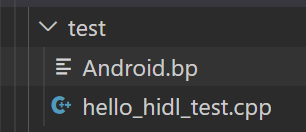写给应用开发的 Android Framework 教程是一个系列教程,目前已更新以下内容:
- Android Framework 学习路线指南
- 系统开发基础
- AOSP 上手指南
- 学穿 Binder 系列
- HAL 与硬件服务
- Kernel 下载与编译
- Linux 驱动开发入门
- Hal 层添加访问 linux 驱动的接口 (本文)
本文基于 AOSP Android10 r41 源码环境
1. Android O 后的 HAL —— Treble 计划
在 Android O 以前,framework 与 hal 是紧耦合的存在于 system.img 中,因此进行版本升级时需要: OEM 厂商适配 framework ,SoC 厂商适配 hal, 之后将修改打包到system.img,生成 OTA 升级包,推送到手机进行 OTA 升级。
在 Android O 以后,framework 与 hal 进行了解耦, framework 存在于system.img,hal 存在于 vendor.img ,进行版本升级时,分为两次升级:
- framework 升级: OEM 厂商适配 framework,将修改打包到system.img, 生成OTA 升级包,推送到手机进行OTA 升级(framework 发生改变,hal 层未变)。
- hal 升级:SoC 厂商适配 hal, 将修改打包到 vendor.img, 生成 OTA 升级包,推送到手机进行 OTA 升级(framework发生改变,hal 层发生改变)。
要实现 Android O 以后的升级方式,需要保证 System 分区与 Vendor 分区之间的接口稳定,Android O 中提供了多种技术来维护这个接口的稳定性,其中最主要的是:
- VNDK:System 分区中的库,这些库 Vendor 分区可能会使用到,这些库由 google 维护和保持其对外的稳定性。
- HIDL:Vendor 分区通过 HIDL 方式来对外提供使用接口,需要 SOC 厂商维护其对外接口的稳定性。
接下来我们就来看看 HIDL 在 HAL 层中的使用。
2. Hal 层的实现
源码可以在 https://github.com/yuandaimaahao/AndroidFrameworkTutorial/tree/main/4.Hal%E4%B8%8E%E7%A1%AC%E4%BB%B6%E6%9C%8D%E5%8A%A1/src/HelloHidl_Bindered 这里下载到。
首先我们需要将 Linux 驱动开发入门 中介绍的 hello 驱动添加到内核中,接着在看下面的操作:
2.1 Hal 协议实现
Hal 层的实现一般放在 vendor 目录下,我们在 vendor 目录下创建如下的目录:
mkdir -p jelly/hardware/interface/hello_hidl/1.0接着在 vendor/jelly/hardware/interface/hello_hidl/1.0 目录下创建 Hal 文件;
IHello.hal :
//定义包名,最后跟一个版本号
package jelly.hardware.hello_hidl@1.0;
//定义 hidl 服务对外提供的接口
interface IHello {
//for test,generates 后面跟的是返回类型
addition_hidl(uint32_t a,uint32_t b) generates (uint32_t total);
//写 hello 驱动
write(string name) generates (uint32_t result);
//读 hello 驱动
read() generates (string name);
};这里的 IHello.hal 定义了我们的服务对外提供了哪些函数。可以认为这就是我们服务的对外协议。协议一般定义好就不会再修改,以保持对外的稳定性。
关于 hal 的写法,可以参考官方的文档,另外也可以参考 hardware 目录下系统自带的 hal 的写法。
2.2 hal 文件生成 C++ 源文件
接着我们使用 hidl-gen 命令将我们写的 hal 文件转换为 C++ 文件:
source build/envsetup.sh
PACKAGE=jelly.hardware.hello_hidl@1.0
LOC=vendor/jelly/hardware/interfaces/hello_hidl/1.0/default
hidl-gen -o $LOC -Lc++-impl -rjelly.hardware:vendor/jelly/hardware/interfaces $PACKAGE接着就会生成一些 C++ 代码:
在 vendor/jelly/hardware/interfaces/hello_hidl/1.0/default 目录下会生成 Hello.cpp 和 Hello.h
在 out/soong/.intermediates/vendor/jelly/hardware/interfaces/hello_hidl/1.0/jelly.hardware.hello_hidl@1.0_genc++/gen/jelly/hardware/hello_hidl/1.0 中生成了如下代码:

在 out/soong/.intermediates/vendor/jelly/hardware/interfaces/hello_hidl/1.0/jelly.hardware.hello_hidl@1.0_genc++_headers/gen/jelly/hardware/hello_hidl/1.0 中生成了如下代码:

接着修改 vendor/jelly/hardware/interfaces/hello_hidl/1.0/default 目录下生成的 Hello.cpp:
// FIXME: your file license if you have one
#include "Hello.h"
#include <log/log.h>
#include <sys/types.h>
#include <sys/stat.h>
#include <fcntl.h>
#include <unistd.h>
#include <stdio.h>
namespace jelly {
namespace hardware {
namespace hello_hidl {
namespace V1_0 {
namespace implementation {
// Methods from ::jelly::hardware::hello_hidl::V1_0::IHello follow.
Return<uint32_t> Hello::addition_hidl(uint32_t a, uint32_t b) {
ALOGE("hello_hidl service is init success....a :%d,b:%d",a,b);
return uint32_t {};
return uint32_t {};
}
Return<uint32_t> Hello::write(const hidl_string& name) {
int fd = open("/dev/hello", O_RDWR);
if (fd == -1)
{
printf("can not open file /dev/hello\n");
return uint32_t { 0 };
}
::write(fd, name.c_str(), 100);
close(fd);
return uint32_t { 1 };
}
//通过 read_cb function 回调函数,回传数据
Return<void> Hello::read(read_cb _hidl_cb) {
char buf[100];
int fd = open("/dev/hello", O_RDWR);
if (fd == -1)
{
printf("can not open file /dev/hello\n");
return Void();
}
::read(fd, buf, 100);
hidl_string result(buf);
_hidl_cb(result);
close(fd);
return Void();
}
} // namespace implementation
} // namespace V1_0
} // namespace hello_hidl
} // namespace hardware
} // namespace jelly这里主要是对我们的协议进行实现,实现了对上一节实现的设备文件 /dev/hello 的读写。至此我们的 hidl 服务就定义好了
2.3 服务端实现
接着我们需要写一个 Server 端来向 HwServiceManager 注册我们的服务。在 vendor/jelly/hardware/interfaces/hello_hidl/1.0/default 目录下添加 service.cpp:
#include <hidl/HidlTransportSupport.h>
#include <utils/Looper.h>
#include <utils/StrongPointer.h>
#include <log/log.h>
#include "Hello.h"
using android::hardware::configureRpcThreadpool;
using android::hardware::joinRpcThreadpool;
using jelly::hardware::hello_hidl::V1_0::IHello;
using jelly::hardware::hello_hidl::V1_0::implementation::Hello;
int main() {
ALOGD("hello-hidl is starting...");
configureRpcThreadpool(4, true /* callerWillJoin */);
android::sp<IHello> service = new Hello();
android::status_t ret = service->registerAsService();
if (ret != android::NO_ERROR) {
}
joinRpcThreadpool();
return 0;
//Passthrough模式
//return defaultPassthroughServiceImplementation<IHello>(4);
}我们的服务端需要在开机时启动,创建 vendor/jelly/hardware/interfaces/hello_hidl/1.0/default/jelly.hardware.hello_hidl@1.0-service.rc 文件:
service vendor_hello_hidl_service /vendor/bin/hw/jelly.hardware.hello_hidl@1.0-service
class hal
user system
group system接着我们需要添加 VINTF 对象,对于注册到 hwservicemanager 的服务都需要添加一个 VINTF 对象。对于编码来说 VINTF 对象就是一个 xml 文件,创建 vendor/jelly/hardware/interfaces/hello_hidl/1.0/default/jelly.hardware.hello_hidl@1.0-service.xml 文件:
<manifest version="1.0" type="device">
<hal format="hidl">
<name>jelly.hardware.hello_hidl</name>
<transport>hwbinder</transport>
<version>1.0</version>
<interface>
<name>IHello</name>
<instance>default</instance>
</interface>
</hal>
</manifest>2.4 生成 Android.bp
接着我们来生成 Android.bp:
hidl-gen -o $LOC -Landroidbp-impl -rjelly.hardware:vendor/jelly/hardware/interfaces $PACKAGE这个命令会在 vendor/jelly/hardware/interfaces/hello_hidl/1.0/default 目录下生成一个 Android.bp,我们在生成的基础上稍作修改如下:
// FIXME: your file license if you have one
cc_library_shared {
name: "jelly.hardware.hello_hidl@1.0-impl",
relative_install_path: "hw",
proprietary: true,
srcs: [
"Hello.cpp",
],
shared_libs: [
"libhidlbase",
"libhidltransport",
"libutils",
"jelly.hardware.hello_hidl@1.0",
"liblog",
],
}
cc_binary {
name: "jelly.hardware.hello_hidl@1.0-service",
init_rc: ["jelly.hardware.hello_hidl@1.0-service.rc"],
vintf_fragments: ["jelly.hardware.hello_hidl@1.0-service.xml"],
defaults: ["hidl_defaults"],
relative_install_path: "hw",
vendor: true,
srcs: ["service.cpp", "Hello.cpp"],
shared_libs: [
"jelly.hardware.hello_hidl@1.0",
"libhardware",
"libhidlbase",
"libhidltransport",
"libutils",
"liblog",
],
}生成的库里面有一个依赖 jelly.hardware.hello_hidl@1.0,接着我们来生成这个库对应的 Android.bp:
在 hardware/interfaces 目录下将 update-makefiles.sh
拷贝到 vendor/jelly/hardware/interfaces/ 目录下,并修改如下:
#!/bin/bash
source $ANDROID_BUILD_TOP/system/tools/hidl/update-makefiles-helper.sh
do_makefiles_update \
"jelly.hardware:vendor/jelly/hardware/interfaces"接着执行:
./vendor/jelly/hardware/interfaces/update-makefiles.sh就会生成 vendor/jelly/hardware/interfaces/Android.bp 文件:
hidl_interface {
name: "jelly.hardware.hello_hidl@1.0",
root: "jelly.hardware",
srcs: [
"IHello.hal",
],
interfaces: [
"android.hidl.base@1.0",
],
gen_java: false,
}其中的 hidl_interface 是 hidl 独有的,当编译源码时,它会将 out/soong/.intermediates/vendor/jelly/hardware/interfaces/hello_hidl/1.0/jelly.hardware.hello_hidl@1.0_genc++/gen/jelly/hardware/hello_hidl/1.0 和 out/soong/.intermediates/vendor/jelly/hardware/interfaces/hello_hidl/1.0/jelly.hardware.hello_hidl@1.0_genc++_headers/gen/jelly/hardware/hello_hidl/1.0 目录下的源码编译为 jelly.hardware.hello_hidl@1.0.so 文件,并预制到手机的 /vendor/lib 和 /vendor/lib64/ 目录下。
为了使编译通过,新建 vendor/jelly/hardware/interfaces/Android.bp 文件:
hidl_package_root {
name: "jelly.hardware",
path: "vendor/jelly/hardware/interfaces",
}这个 Android.bp 的作用是告诉编译系统包名与路径的映射关系。
接着新建 vendor/jelly/hardware/interfaces/current.txt 文件,current.txt 记录了所有 hal 接口的 hash 值,接口有变化时,同时需要更新 current.txt 中的 hash 值,这是我们先随便设置一个 hash 值:
123456 jelly.hardware.hello_hidl@1.0::IHello再执行一遍 update-makefiles.sh,这个时候就会发现提示 hash 值不正确了,同时会给出正确的 hash 值,我们把正确的 hash 值替换到 current.txt 即可。
2.5 客户端编写
在 vendor/jelly/hardware/interfaces/hello_hidl/1.0/default 目录下创建如下的文件和文件夹:

其中 hello_hidl_test.cpp:
#include <jelly/hardware/hello_hidl/1.0/IHello.h>
#include <hidl/LegacySupport.h>
#define LOG_TAG "hello_hidl"
#include <log/log.h>
using android::sp;
using jelly::hardware::hello_hidl::V1_0::IHello;
using android::hardware::Return;
using android::hardware::hidl_string;
int main(){
android::sp<IHello> hw_device = IHello::getService();
if (hw_device == nullptr) {
ALOGD("failed to get hello-hidl");
return -1;
}
ALOGD("success to get hello-hidl....");
Return<uint32_t> total = hw_device->addition_hidl(3,4);
hw_device->write("hello");
hw_device->read([&](hidl_string result){
ALOGD("%s\n", result.c_str());
});
return 0;
} Android.bp:
cc_binary {
name: "hello_hidl_test",
srcs: ["hello_hidl_test.cpp"],
vendor: true,
shared_libs: [
"liblog",
"jelly.hardware.hello_hidl@1.0",
"libhidlbase",
"libhidltransport",
"libhwbinder",
"libutils",
],
}2.6 selinux 配置
在 device/Jelly/Rice14/sepolicy 目录下添加:
device.te 中添加如下内容:
type hello_hidl_dev_t, dev_type;hwservice.te:
type hello_hidl_hwservice, hwservice_manager_type;hello_hidl.te:
type hello_hidl, domain;
type hello_hidl_exec, exec_type, vendor_file_type, file_type;
init_daemon_domain(hello_hidl);
add_hwservice(hello_hidl, hello_hidl_hwservice)
hwbinder_use(hello_hidl)
allow hello_hidl hidl_base_hwservice:hwservice_manager { add };
allow hello_hidl hello_hidl_dev_t:chr_file { open read write };
binder_call(hello_hidl,hwservicemanager)
get_prop(hello_hidl,hwservicemanager_prop)hwservice_contexts:
jelly.hardware.hello_hidl::IHello u:object_r:hello_hidl_hwservice:s0hello_hidl_test.te
type hello_hidl_test, domain;
type hello_hidl_test_exec, exec_type, vendor_file_type, file_type;
domain_auto_trans(shell, hello_hidl_test_exec, hello_hidl_test);
get_prop(hello_hidl_test, hwservicemanager_prop)
allow hello_hidl_test hello_hidl_hwservice:hwservice_manager find;
hwbinder_use(hello_hidl_test);在 file_contexts 中添加:
/dev/hello u:object_r:hello_hidl_dev_t:s0
/vendor/bin/hw/jelly\.hardware\.hello_hidl@1\.0-service u:object_r:hello_hidl_exec:s0注意,file_contexts 最后必须留一行空行,不然会编译失败
2.7 编译执行
接着在 device/Jelly/Rice14/Rice14.mk 中添加如下内容:
BOARD_SEPOLICY_DIRS += \
device/Jelly/Rice14/sepolicy
PRODUCT_PACKAGES += \
jelly.hardware.hello_hidl@1.0-service \
hello_hidl_test \
jelly.hardware.hello_hidl@1.0-impl \然后整编系统:
source
lunch 1
make -j16最后测试:
# 执行客户端程序
hello_hidl_test &
# 查看 log
# logcat | grep hello
05-03 14:20:19.816 1555 1555 D : hello-hidl is starting...
05-03 14:20:19.816 1555 1555 I ServiceManagement: Registered jelly.hardware.hello_hidl@1.0::IHello/default (start delay of 36ms)
05-03 14:20:19.816 1555 1555 I ServiceManagement: Removing namespace from process name jelly.hardware.hello_hidl@1.0-service to hello_hidl@1.0-service.
05-03 14:20:38.843 3469 3469 D hello_hidl: success to get hello-hidl....
05-03 14:20:38.843 1555 1563 E hello_hidl: hello_hidl service is init success....a :3,b:4
05-03 14:20:38.844 1555 1563 D hello_hidl: service is writing
05-03 14:20:40.846 1555 1563 D hello_hidl: service is reading
05-03 14:20:40.847 3469 3469 D hello_hidl: hello可以看到我们的客户端已经访问到服务端了。
后续
以上是通过 hwbinder 跨进程通信的方式,来实现的。对于效率较高的模块,我们还是希望通过 dlopen 直接加载的方式来使用 hal 层。Android 的 Hidl 框架也是提供了支持的。这种方式称为直通模式(passthrough),这部分内容会在下一篇教程中讲解。
参考资料
- Android系统开发入门-11.添加hidl服务
- Android系统开发入门-12.hidl服务回调
- Android HIDL模型下HAL Service添加SELinux规则实战
- ROC-RK3399-PC Pro Android10 源码
- 一个简单的HIDL开发笔记
- 简单HIDL HAL的实现
- hidl 服务启动流程
- SElinux权限配置
- AndroidO Treble架构下Hal进程启动及HIDL服务注册过程
- Android10.0 Binder通信原理(一)Binder、HwBinder、VndBinder概要
- 系统角度解读Android P新特性
- Android : 供应商原生开发套件 (VNDK)
- android 自定义驱动(第三篇:HIDL服务端)
1、本站所有资源均从互联网上收集整理而来,仅供学习交流之用,因此不包含技术服务请大家谅解!
2、本站不提供任何实质性的付费和支付资源,所有需要积分下载的资源均为网站运营赞助费用或者线下劳务费用!
3、本站所有资源仅用于学习及研究使用,您必须在下载后的24小时内删除所下载资源,切勿用于商业用途,否则由此引发的法律纠纷及连带责任本站和发布者概不承担!
4、本站站内提供的所有可下载资源,本站保证未做任何负面改动(不包含修复bug和完善功能等正面优化或二次开发),但本站不保证资源的准确性、安全性和完整性,用户下载后自行斟酌,我们以交流学习为目的,并不是所有的源码都100%无错或无bug!如有链接无法下载、失效或广告,请联系客服处理!
5、本站资源除标明原创外均来自网络整理,版权归原作者或本站特约原创作者所有,如侵犯到您的合法权益,请立即告知本站,本站将及时予与删除并致以最深的歉意!
6、如果您也有好的资源或教程,您可以投稿发布,成功分享后有站币奖励和额外收入!
7、如果您喜欢该资源,请支持官方正版资源,以得到更好的正版服务!
8、请您认真阅读上述内容,注册本站用户或下载本站资源即您同意上述内容!
原文链接:https://www.dandroid.cn/archives/20566,转载请注明出处。


评论0